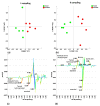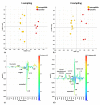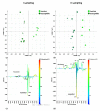Olive Cultivars Susceptible or Tolerant to Xylella fastidiosa Subsp. pauca Exhibit Mid-Term Different Metabolomes upon Natural Infection or a Curative Treatment
- PMID: 33920775
- PMCID: PMC8103516
- DOI: 10.3390/plants10040772
Olive Cultivars Susceptible or Tolerant to Xylella fastidiosa Subsp. pauca Exhibit Mid-Term Different Metabolomes upon Natural Infection or a Curative Treatment
Abstract
Xylella fastidiosa subsp. pauca, is a bacterial phytopathogen associated with the "olive quick decline syndrome" (OQDS) causing severe economic losses to olive groves in Salento area (Apulia, Italy). In a previous work, we analyzed by 1H-NMR the metabolic pattern of naturally infected Ogliarola salentina and Cellina di Nardò susceptible cultivars untreated and treated with a zinc-copper citric acid biocomplex and we observed the treatment related variation of the disease biomarker quinic acid. In this study, we focused also on the Leccino cultivar, known to exhibit tolerance to the disease progression. The 1H-NMR-based metabolomic approach was applied with the aim to characterize the overall metabolism of tolerant Leccino in comparison with the susceptible cultivars Ogliarola salentina and Cellina di Nardò under periodic mid-term treatment. In particular, we studied the leaf extract molecular patterns of naturally infected trees untreated and treated with the biocomplex. The metabolic Leccino profiles were analyzed for the first time and compared with those exhibited by the susceptible Cellina di Nardò and Ogliarola salentina cultivars. The study highlighted a specificity in the metabolic response of the tolerant Leccino compared to susceptible cultivars. These differences provide useful information to describe the defensive mechanisms underlying the change of metabolites as a response to the infection, and the occurrence of different levels of disease, season and treatment effects for olive cultivars.
Keywords: 1H-NMR spectroscopy; Xylella fastidiosa; metabolomics; susceptible cultivar; tolerant cultivar.
Conflict of interest statement
The authors declare no conflict of interest.
Figures










References
-
- Sardaro R., Fucilli V., Acciani C. Measuring the value of rural landscape in support of preservation policies. Sci. Reg. 2015:125–138. doi: 10.3280/scre2015-002005. - DOI
-
- ISTAT. [(accessed on 25 September 2020)]; Available online: http://dati.istat.it/
-
- Martelli G.P. The current status of the quick decline syndrome of olive in southern Italy. Phytoparasitica. 2016;44:1–10. doi: 10.1007/s12600-015-0498-6. - DOI
-
- Cimato A., Sani G., De Rinaldis G., Calogiuri A. Recupero, Conservazione, Selezione e Caratterizzazione delle Varietà Autoctone. Camera di Commercio, Industria, Artigianato e Agricoltura; Lecce, Italy: 2001. Il germoplasma olivicolo in provincia di Lecce.
-
- Del Coco L., De Pascali S.A., Fanizzi F.P. NMR-metabolomic study on monocultivar and blend salento EVOOs including some from secular olive trees. Food Nutr. Sci. 2014;5:89–95.
LinkOut - more resources
Full Text Sources
Other Literature Sources

